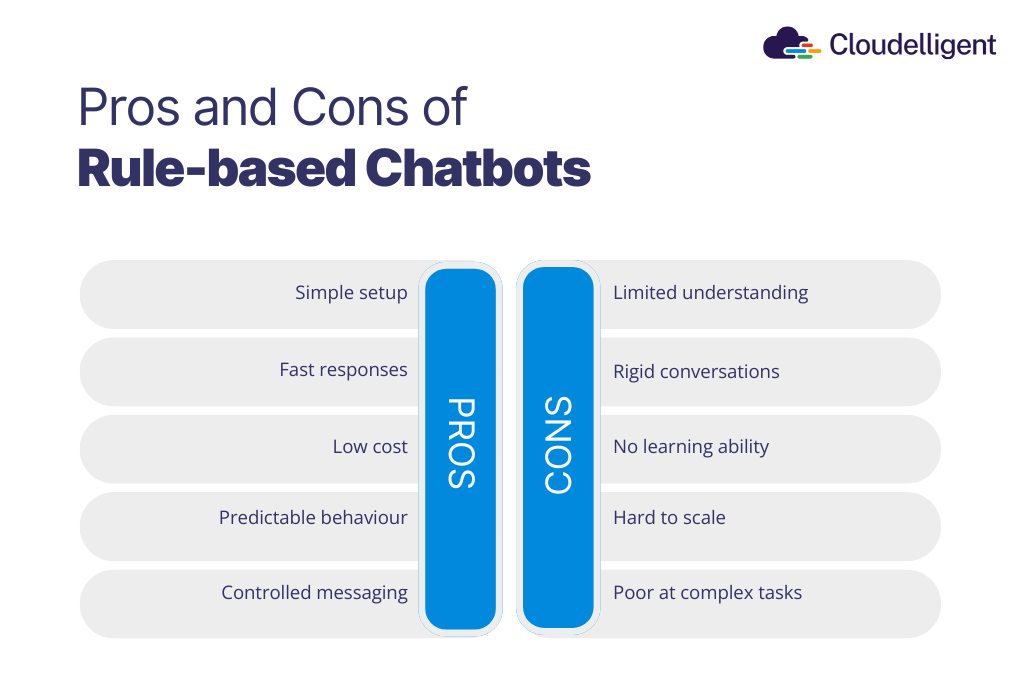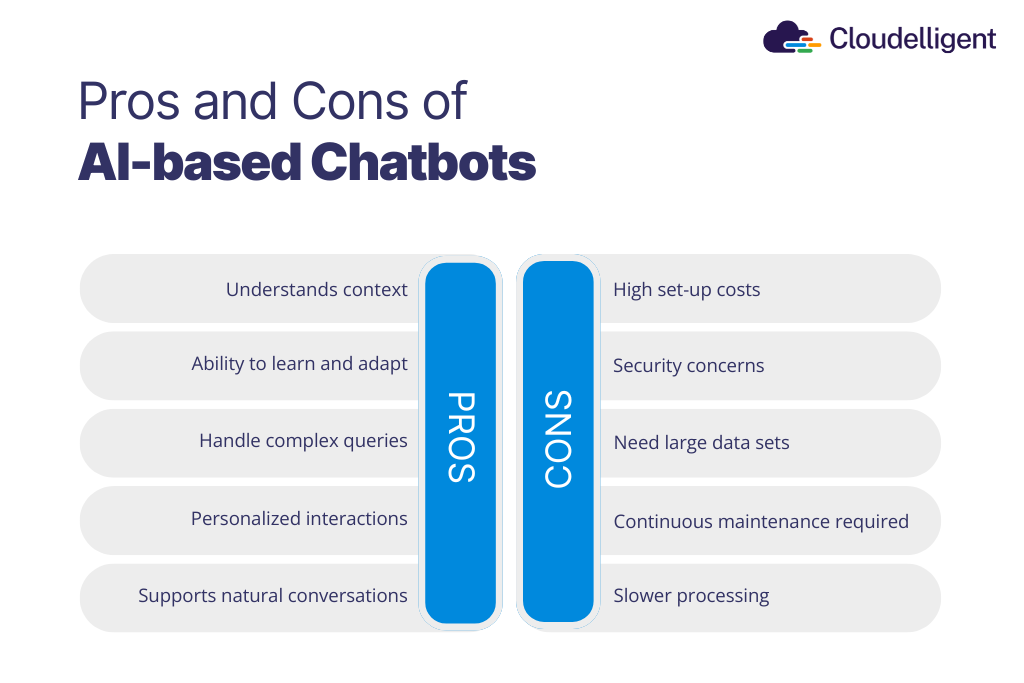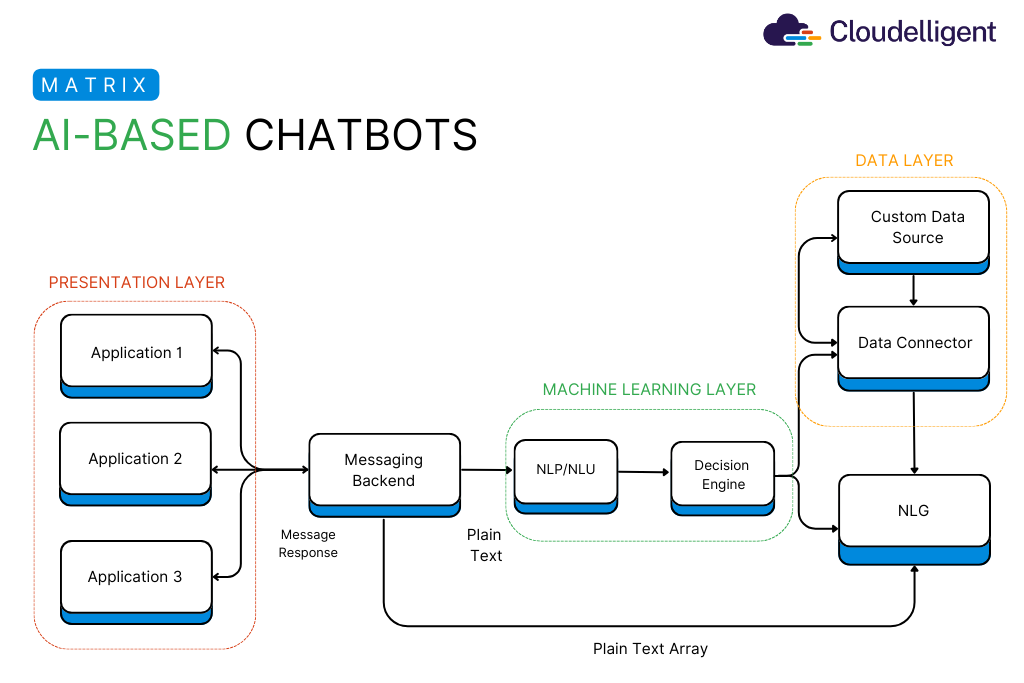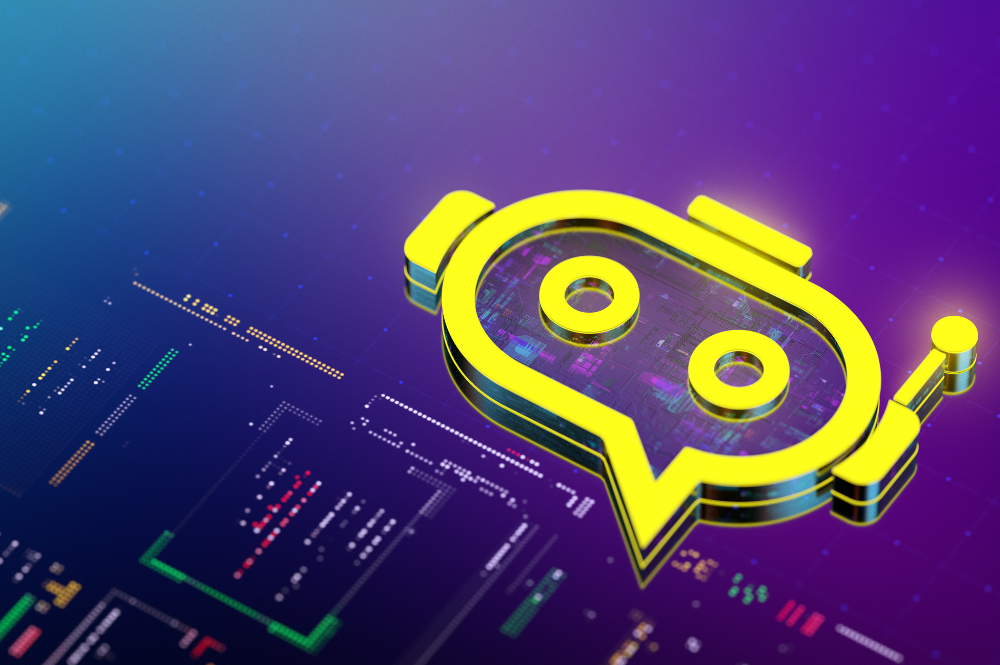The future of customer service isn’t just about efficiency; it’s about creating meaningful connections. Chatbots are leading the way! By leveraging AI-driven technology, businesses can deliver faster, more personalized experiences—often with remarkable success. As per a recent Gartner Digital Markets report, 92% of companies are considering investing in AI-powered software in 2024. In this blog, we will delve into the exciting potential of chatbots vs AI, exploring their key features and various types. You’ll also find essential insights to help you choose the right chatbot for your needs and guidance on developing chatbots on AWS.
What’s the Ideal Chatbot for Your Business Success?
The right chatbot can be a game-changer for your business, transforming customer interactions and driving success. But with so many options, how do you know which is the perfect fit? To make an informed decision, it’s essential to understand the different types of chatbots available.
- Rule-based Chatbots: Operate using predefined scripts and workflows to handle specific queries.
- AI-powered Chatbots: Use machine learning and natural language processing to offer more personalized and dynamic responses.
- Hybrid Chatbots: Combine rule-based and AI capabilities, providing structured guidance and intelligent adaptability.

Figure 1: Example of AI vs Rule-based Chatbots
While AI chatbots may seem more advanced, we shouldn’t overlook the usability benefits of Rule-based chatbots, which provide quick and accurate responses to predefined queries. Businesses should assess their specific needs and user expectations when choosing between AI and Rule-based chatbots, as each offers unique advantages for enhancing customer engagement. Here is a more detailed overview of both types of chatbots.
1. Rule-based Chatbots
A Rule-based chatbot is powered by preprogrammed rules, designed to respond to customer inquiries and offer solutions through structured and reliable pathways. It’s built to handle frequently asked questions and perform simple tasks precisely and efficiently.

Figure 2: Pros and Cons of Rule-based Chatbots
Rule-based chatbots are further categorized into two kinds:
- Button or menu-based chatbots: These chatbots offer users a predefined list of questions and corresponding answers. Hence, the responses are limited, and only basic conversations can take place.
- Keyword recognition-based chatbots: Keyword recognition chatbots allow users to write their questions and identify key terms to trigger corresponding answers. The downside is that they may provide irrelevant responses if the keywords don’t match the predefined database exactly.
So how do Rule-based chatbots work? These operate using a decision tree matrix that directs customers toward specific actions. The rules that govern these chatbots and the scripts they follow are predetermined, meaning they remain static unless manually updated by the organization that created the chatbot. Below is an example of a rule-based chatbot.

Figure 3: Rule-Based Chatbot Matrix
2. AI-powered Chatbots
AI-based chatbots are complex programs that mimic natural human conversation and understand queries regardless of wording, unlike rule-based chatbots. Moreover, these bots are powered by AI algorithms and can interpret human speech, learn from interactions, and generate relevant responses using vast datasets.

Figure 4: Pros and Cons of AI-based Chatbots
These chatbots are further categorized into two types:
- Text chatbots: These are AI-powered bots that communicate with users through written text, providing responses and solutions in a chat format.
- Voice chatbots: AI-driven bots such as Amazon Alexa, a cloud-based voice service that interacts with users through voice, recognizes spoken language, and responds with conversational speech.
AI chatbots leverage the power of Artificial Intelligence and natural language processing (NLP) to go beyond mere comprehension of message content. This advanced capability allows them to accurately discern the intent behind each user message, enabling responses that are genuinely helpful and contextually relevant. Unlike their Rule-based counterparts, AI chatbots don’t stick to a rigid script; they dynamically learn from data, crafting personalized responses tailored to individual customer inputs. As they interact with users, they continuously gather insights, refining their skills and enhancing their effectiveness over time. Below is a typical matrix for an AI-based chatbot:

Figure 5: AI-based Chatbot Matrix
3. Hybrid Chatbots
If you’re seeking a combination of features, hybrid chatbots merge the strengths of rule-based and AI-powered systems to provide a versatile and efficient conversational experience. The rule-based component handles routine tasks, such as checking order status and addressing FAQs, while the AI-powered aspect manages complex, context-driven queries and delivers relevant responses.
What Else to Consider When Choosing a Chatbot?
Selecting the right type of chatbot depends on your specific requirements and the pros and cons we’ve discussed. Additionally, here are some key factors to consider before making your decision:
1. Alignment with Business Goals
When selecting a chatbot, it’s crucial to ensure that its capabilities align with your overarching business goals. This means identifying how the chatbot can support specific objectives, such as improving customer service, increasing sales, or enhancing user engagement.
2. Seamless Integration Capabilities
Look for chatbots that can seamlessly integrate with your existing systems and software, such as customer relationship management (CRM) tools, e-commerce platforms, and communication channels.
3. Meeting Customer Expectations
A successful chatbot should meet the expectations of your customers by providing quick and efficient service. Consider features like natural language processing (NLP) and machine learning that allow the chatbot to understand and respond to customer inquiries effectively.
4. Budgeting for Implementation and Maintenance
While chatbots can lead to significant cost savings in the long run by automating routine tasks, it’s essential to evaluate the initial investment, ongoing maintenance, and potential return on investment (ROI).
5. Ensuring Scalability and Compatibility
Choose a chatbot that can grow with your business. It should be scalable to accommodate increasing customer interactions and adaptable to various platforms and technologies.
Practical Chatbot Applications to Upscale Your Business
In this section, let’s dive deeper into the practical applications of AI chatbots and Rule-based chatbots highlighting how they are being utilized:
1. Customer Support Automation
Chatbots automate repetitive customer inquiries, allowing faster response times and reducing workload for support teams. Companies use chatbots to assist customers with product recommendations and order tracking, enhancing customer support while reducing human intervention.
2. Operational Monitoring
Chatbots monitor systems, provide real-time alerts for issues, and ensure continuous operations. For instance, chatbot applications can be used to monitor infrastructures, detect anomalies, and notify teams to prevent system failures.
3. Task Automation
Chatbots handle repetitive tasks, such as scheduling, reminders, or routine workflows, to boost productivity. They may be used to automate scheduling meetings, sending reminders, and managing tasks for teams.
4. Team Collaboration
Chatbots facilitate communication within teams and enhance workflow management, ensuring seamless collaboration across departments.
5. Data Retrieval and Insights
Chatbots access and analyze large data sets, delivering actionable insights or answers in real-time. Some chatbot applications include retrieving financial data for customers and providing insights into spending patterns and investment portfolios.
6. Personalized Recommendations
Smart chatbots analyze user behavior to offer tailored suggestions, enhancing customer support and engagement. For example, Spotify is a practical application of an AI chatbot used to recommend songs and playlists based on users’ listening habits, creating a personalized experience.
7. Onboarding and Training
Chatbots may guide new customers through onboarding processes, provide training resources, and answer questions. HubSpot is a popular marketing tool that uses chatbots to walk new employees through the onboarding process, answering FAQs and providing training materials.
8. Integration with AWS Services
Chatbots integrated with AWS services empower businesses to enhance functionality and deliver exceptional customer experiences. By leveraging Amazon Lex in conjunction with other AWS services, companies can streamline customer support, automate data retrieval, and optimize workflows in the cloud. Furthermore, services such as AWS Lambda, Amazon DynamoDB, and Amazon S3 streamline data handling, automation, and storage to ensure seamless and efficient customer interactions.
To dive deeper into how Amazon Bedrock can revolutionize your chatbot development and leverage the power of generative AI, check out our blog: Harnessing the Power of Generative AI With Amazon Bedrock.
Building Chatbots on AWS
By leveraging AWS services, businesses can develop sophisticated, natural language chatbots that provide highly personalized user experiences. Collaborating with AWS partners such as Cloudelligent can accelerate the development and deployment of chatbots on AWS, enabling you to engage customers effectively and address their unique needs.
To build advanced chatbots on AWS, you can leverage several key services that play a vital role in enhancing their functionality and user experience. Here’s how each service contributes to creating a more intelligent and responsive chatbot:
- Amazon Bedrock enhances the development of advanced chatbots by offering access to foundational models. This enables organizations to create highly customizable and powerful conversational agents tailored to their specific requirements.
- Amazon Lex facilitates the creation of conversational interfaces using advanced natural language understanding (NLU) and automatic speech recognition (ASR), allowing users to interact naturally through text or voice.
- Amazon Polly enhances these interactions by converting text into lifelike speech and provides a more engaging experience for users.
- Amazon Connect seamlessly integrates with the chatbot to enable smooth transitions to live agents when more complex issues arise. This ensures that customers receive the support they need without interruption.
- Amazon Comprehend offers powerful text analysis capabilities, allowing chatbots to understand context and sentiment. This can help inform responses and improve interactions.
- Amazon Personalize enables businesses to tailor recommendations and content based on individual user preferences and behavior, enhancing engagement further.
Embracing the Chatbot Revolution With Cloudelligent
Imagine providing instant responses to inquiries and personalized support around the clock—all while freeing up your team to focus on more complex challenges. Cloudelligent is here to guide you on your journey toward automation and efficiency. By leveraging AWS tools, we can help to build chatbots that automate your customers’ experiences, enhancing satisfaction and engagement.
Ready to transform your customer service? Schedule a Free Cloud AI and Machine Learning Consultation today and discover how we can help you harness the power of chatbots.










